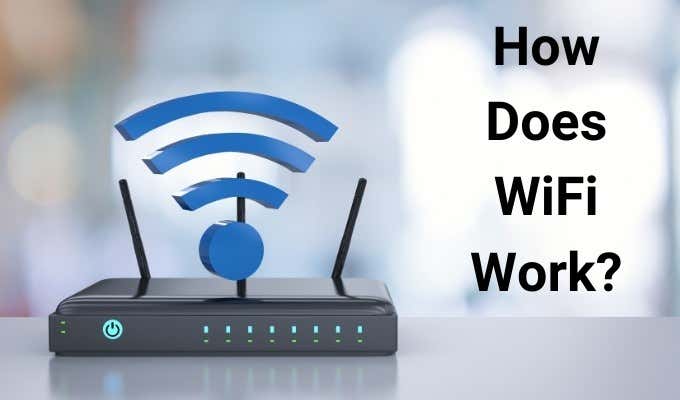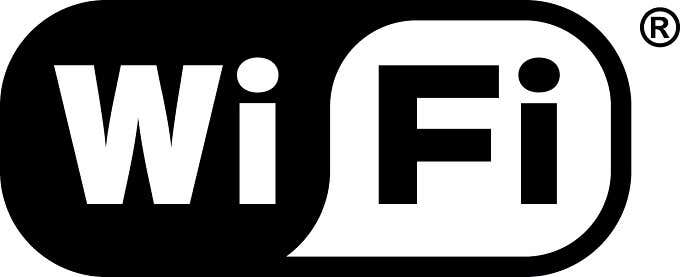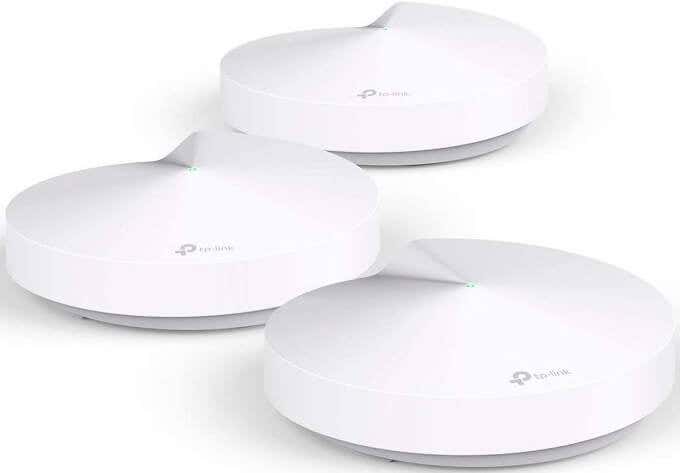WiFi is a wireless networking technology that lets you connect your WiFi-enabled devices to a local network. Using WiFi you can transfer data between local network devices or connect to the internet, if a connection is available. Most people probably know this, since we all use WiFi every day, but how does WiFi actually work?

WiFi Is Radio
The most fundamental fact about WiFi is that it uses radio waves to transmit information. Radio waves are what we call a specific frequency range of electromagnetic radiation. Light is the portion of the spectrum our eyes are sensitive to, but is made of the same “stuff” as radio waves.
WiFi uses two different frequencies for transmission: 2.4Ghz and 5Ghz. That’s 2,400,000,000 and 5,000,000,000 cycles per second respectively. This is pretty high compared to FM radio which has a frequency of only about 100Mhz.
The exact frequency of a radio wave changes a lot about its characteristics. With a higher frequency, you can pack more information into your signal. However, some frequencies don’t have very long ranges.

Different frequencies also penetrate matter differently. Some frequencies can be bounced off the atmosphere, so your transmitter and receiver don’t need line-of-sight to work. Other frequencies just shoot straight out into space. That’s useful if you want to communicate with a satellite, not so much if the receiver is on Earth.
Waves at the WiFi operating frequencies can reach hundreds of miles if you put enough wattage into the transmission power, have nothing in the way and use the right antenna. However, standard household WiFi usually has an unobstructed range of between 30-50 meters (approx 100/150 feet). 2.4Ghz WiFi has the longer range, 5Ghz WiFi has higher speeds.
WiFi Is Digital
WiFi is radio, but it’s digital radio. That means the radio waves are modulated to carry digital code. WiFi is absolutely packed with digital information.

The latest and greatest WiFi technology has a theoretical speed limit of 4.8 Gbps, using four 1.2Gbps data streams at once. That’s 600 megabytes per second! Of course, theoretical speeds are determined in a lab under optimal conditions, but even in the real world modern WiFi is very fast.
WiFi Has Standards & Protocols
WiFi has been around for a long time.The first commercial iteration of the technology was released all the way back in 1997. The Institute of Electrical and Electronics Engineers (IEEE) codified the WiFi standard, which is officially known as IEEE 802.11. The first generation of WiFi is known as 802.11a, but as time went by newer, better versions of WiFi were developed:
- 802.11a
- 802.11b
- 802.11g
- 802.11n
- 802.11ac
- 802.11ax

WiFi is not fully backwards compatible. You won’t find many modern devices that can still communicate with 802.11a devices. Many WiFi devices out there are “bgn” and will work with those three standards, which all use the 2.4Ghz frequency band. 802.11ac uses the 5Ghz band, but most of these routers are “dual band” and also offer 2.4Ghz to talk to older devices using older standards.
In practice backwards compatibility with WiFi is spotty, since some devices are locked to certain speeds within each respective standard. Newer routers may not let things go that slowly!
Incidentally, the whole “802.11” naming convention has been dropped. The latest 802.11ax is now known as WiFi 6, with 802.11 being WiFi 5 and so on.
WiFi Is Encrypted
Anyone can intercept WiFi radio waves, but thanks to digital encryption they can’t simply eavesdrop on what’s being sent and received. At least, this is the case if your WiFi network is password protected.
Your WiFi password is also the encryption key, so anyone with the password can see all the data packets unfiltered. This is why you should only use websites that are HTTPS enabled and always use a VPN service if you’re using a public WiFi hotspot!

Your WiFi devices are most likely using WPA2. WPA is short for WiFi Protected Access and is a very strong encryption scheme for WiFi connections. However, over the years hackers have discovered various exploits that, in some cases, allow them to break the WPA2 encryption protocols.
In 2018 the WiFi Alliance, which is the custodian of WiFi technology, announced WPA3. This new version improves security and plugs the security holes found in WPA2. Of course, it will be some time before all hardware out in the wild will support the new security standard.
WiFi Direct Is a Thing
WiFi was designed to use a central device such as a router to manage communication between devices. However, WiFi can also be used to directly connect two devices in what’s known as a “peer-to-peer” connection. This is very handy when, for example, you want to send a large file to someone’s smartphone from yours.

This is also the type of WiFi that’s often used to cast video from a phone to a smart TV. When you use devices such as GoPro cameras or certain WiFi cameras drones, you’re also using a direct WiFi connection. Bluetooth gets most of the attention in the peer-to-peer wireless connection world, especially since it’s so energy efficient, but WiFi direct is fast and just as simple to use.
Routers, Repeaters & Mesh Networks
While direct WiFi connections are commonplace these days, the WiFi we all use most of the time make use of a hub-and-spoke design. In other words, all of your WiFi devices connect to a central device, which acts as the go-between. For most people, this is going to be the common WiFi router.
Modern routers boast multiple antennas, separating different frequency bands as well as the hardware that sends and receives WiFi data. These routers also handle your internet connection and any wired Ethernet devices on your network, allowing the wired and wireless networks to communicate with each other.

However, as we said above, WiFi signal ranges are pretty limited. Which means that the further you are from the router, the worse the signal strength is. A WiFi repeater can be used to extend that signal at the edge of the coverage range.
While repeaters work well enough, there’s a new trend towards “mesh” WiFi systems. Here, there’s no central router. Instead several smaller routers are spread across your home, connected to each other and providing a seamless cloud of WiFi. This is the WiFi technology most commonly used in large businesses, but it’s become affordable for home use.
Beyond WiFi
WiFi is around us more than ever, as all sorts of devices now have a need for a network connection. However, WiFi is not the only competing technology when it comes to wireless data transmission. Bluetooth rules the roost when it comes to low-power, short range connections. Future versions of Bluetooth may even give WiFi a run for its money when it comes to speed and range.
However, the biggest competitor to WiFi might very well be 5G. Fifth-generation cellular technology offers cheaper data rates and dense urban coverage. 5G may not replace WiFi in the home, but 5G offers an alternative to public WiFi hotspots, which have become popular mainly due to the high costs of mobile data.